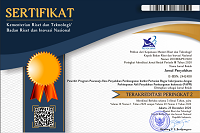STRATEGI PENATAAN KAWASAN PETERNAKAN DI KABUPATEN BLITAR
Keywords:
INAK, social norm, social stratification, social honor
Abstract
The research result shows that the zoning of KINAK is based on the critical and even less productive field for planting. Furthermore, several factors have significant effect on KINAK arrangement social norm system of the local society as well as general and specific layout plant of Blitar regency. The effort of matching KINAK with the availability of potential circumstance and transportation bring about advantages to marketing crops and climate. There has been no change in location enterprise policy. There were two types of work patterns in terms of social-economy such as horizontal and vertical. Horizontally, the work pattern was created among farmers. Vertically the work pattern was built in such a way that farmers have relation to some local poultry shop and Extension Service who are regarded as technical assistant. In addition to it consequence, the arrangement of KINAK has both increased the number of farmer and poultries being raised, and exceded social stratification that is regarded as social honor by people around KINAK.Downloads
Published
2006-03-01
How to Cite
GintingE. (2006). STRATEGI PENATAAN KAWASAN PETERNAKAN DI KABUPATEN BLITAR. Jurnal Penyuluhan, 2(1). https://doi.org/10.25015/penyuluhan.v2i1.2135
Section
Articles
Authors who publish with this journal agree to the following terms:
- Authors retain copyright and grant the journal right of first publication with the work simultaneously licensed under a

This work is licensed under a Creative Commons Attribution 4.0 International License that allows others to share the work with an acknowledgement of the work's authorship and initial publication in this journal. - Authors are able to enter into separate, additional contractual arrangements for the non-exclusive distribution of the journal's published version of the work (e.g., post it to an institutional repository or publish it in a book), with an acknowledgement of its initial publication in this journal.
- Authors are permitted and encouraged to post their work online (e.g., in institutional repositories or on their website) prior to and during the submission process, as it can lead to productive exchanges, as well as earlier and greater citation of published work (See The Effect of Open Access).















